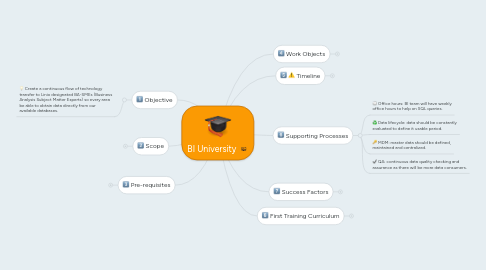
1. Objective
1.1. Create a continuous flow of technology transfer to Linio designated BA-SMEs (Business Analysis Subject Matter Experts) so every area be able to obtain data directly from our available databases.
2. Scope
2.1. Regional. Any team that require direct access to data and need ad-hoc reports for their operation and planning activities.
3. Pre-requisites
3.1. Teams identify the members who may need training.
3.2. Main tables and data are documented.
3.3. Formulas, calculations and logic on fields are documented.
3.4. Tool and/or repository to store documentation is defined (and installed).
3.5. Document maintenance process defined.
4. Timeline
4.1. Identify BA-SMEs
4.1.1. Start: March 1st
4.1.2. Finish: March 13th
4.2. Main documentation
4.2.1. Start: March 17th
4.2.2. Finish: April 17th
4.3. Documentation maintenance definition
4.3.1. Start: March 18th
4.3.2. Finish: March 20th
4.4. Training delivery
4.4.1. CO: Starting Monday April 6th to Friday 10th
4.4.2. PE: Starting Monday April 13th to Friday 17th
4.4.3. MX: Starting Monday April 20th to Friday 24th
4.4.4. NOTE: for CL, AR, PA and EC they should travel to CO, PE or MX training sessions.
5. Work Objects
5.1. Initial Project
5.1.1. Identify BA-SMEs
5.1.1.1. Responsible: each team head
5.1.1.2. Timeframe: one week
5.1.1.3. Output: people list per area per country
5.1.2. Main documentation
5.1.2.1. Responsible: BI
5.1.2.2. Timeframe: 1 month
5.1.2.3. Output: main BI tables documented, main metrics or formulas explained on the tool designated
5.1.3. Documentation maintenance definition
5.1.3.1. Responsible: BI
5.1.3.2. Timeframe: 2 days
5.1.3.3. Output: process flow and responsible(s).
5.1.4. Training delivery – (CO, PE, MX)
5.1.4.1. Responsible: BI
5.1.4.2. Timeframe: one week per country
5.1.4.3. Output: trained members capable of doing simple-mid queries
5.2. Iterative Project
5.2.1. Identify new BA-SMEs
5.2.1.1. Responsible: each team head
5.2.1.2. Timeframe: one week
5.2.1.3. Output: people list per area per country
5.2.2. Identify training needs
5.2.2.1. Responsible: BA-SMEs
5.2.2.2. Timeframe: three days
5.2.2.3. Output: new subjects and topics for the training.
5.2.3. Prepare new content
5.2.3.1. Responsible: BI
5.2.3.2. Timeframe: one week
5.2.3.3. Output: new content curriculum.
5.2.4. Training delivery – (CO, PE, MX)
5.2.4.1. Responsible: BI
5.2.4.2. Timeframe: one week per country
5.2.4.3. Output: trained members capable of doing simple-mid queries
5.2.4.4. NOTE: for CL, AR, PA and EC they should travel to CO, PE or MX training sessions.
6. Supporting Processes
6.1. Office hours: BI team will have weekly office hours to help on SQL queries.
6.2. Data lifecycle: data should be constantly evaluated to define it usable period.
6.3. MDM: master data should be defined, maintained and centralized.
6.4. QA: continuous data quality checking and assurance as there will be more data consumers.
7. Success Factors
7.1. At least 2/3 of the BA-SMEs have business cases (ad-hoc reports or queries).
7.2. Increase on % of decisions made based on data.
7.3. Messages regarding logic doubts decreases at least 50%
7.4. Quality assurance distributed among BA-SMEs, it should trigger around 10% more data checks weekly (while QA is in place)
8. First Training Curriculum
8.1. 2 hours + 30 min for Q&A per session, 5 days, 12 hours total
8.2. Introduction to databases
8.2.1. Relational model
8.2.2. Structured Query Language (SQL)
8.3. The SELECT statement
8.3.1. Databases and tables notation
8.3.2. Data types
8.3.3. Arithmetic operations
8.3.3.1. Interval for dates
8.3.4. NULL values
8.3.5. Table and column aliases
8.3.6. WHERE clause
8.3.7. Duplicated rows
8.3.8. Single row functions
8.3.8.1. Dates
8.3.8.2. Casting
8.3.8.3. Strings
8.3.9. IF, CASE and control statements
8.3.10. GROUP BY
8.3.11. Group or multiple row functions
8.3.11.1. SUM
8.3.11.2. AVG
8.3.11.3. COUNT
8.3.12. HAVING clause
8.3.13. ORDER BY clause
8.4. Subqueries and in-memory tables
8.5. JOINing and UNION tables
8.6. CREATE tables
8.7. Table growth estimation
8.8. Using temporary tables
8.9. The INSERT statement
8.9.1. All and specific columns
8.9.2. Inserting from a SELECT
8.9.3. Bulk or multi-row INSERT
8.10. The UPDATE statement
8.10.1. Validating with a SELECT
8.11. The DELETE statement
8.11.1. Validating with a SELECT
8.12. The TRUNCATE statement
8.12.1. Special grant
8.13. Tips for building complex queries
8.14. Troubleshooting
8.14.1. Finding problems
8.14.2. Optimizing queries 101

